Photography by Coen Wubbels
Unless you fly in, you will have seen a fair share of the Atacama Desert by the time you reach Iquique, whether your Pan-American overland journey takes you southbound or northbound through Chile. No matter how smooth the asphalt that cuts straight through the driest non-polar desert in the world, 995 miles of driving through it is a lot to take in. Vast expanses of pebbles alternating with dunes and beaches made it a perfect setting for a number of Dakar Rally stages, with the climax of blasting down an almost vertical dune just south of Iquique. Fortunately, the Atacama is more than a seemingly endless sandbox. The desert breathes history, culture, and economic wealth—as well as decline. This four-day route, 200 miles from Chile’s northern border with Peru, will allow you to see the best of it, including ancient art and modern history and an incredible variety of scenery. From the desert and the coastal towns of Iquique and Pisagua, roads lead to the altiplano (high plains), where you’ll have the company of llamas, vicuñas, and flamingos. Amidst the colorful palette of mountains are hot springs and salt lakes; you may also enjoy the view of the mighty Isluga stratovolcano and adobe villages with white-plastered homes and churches.

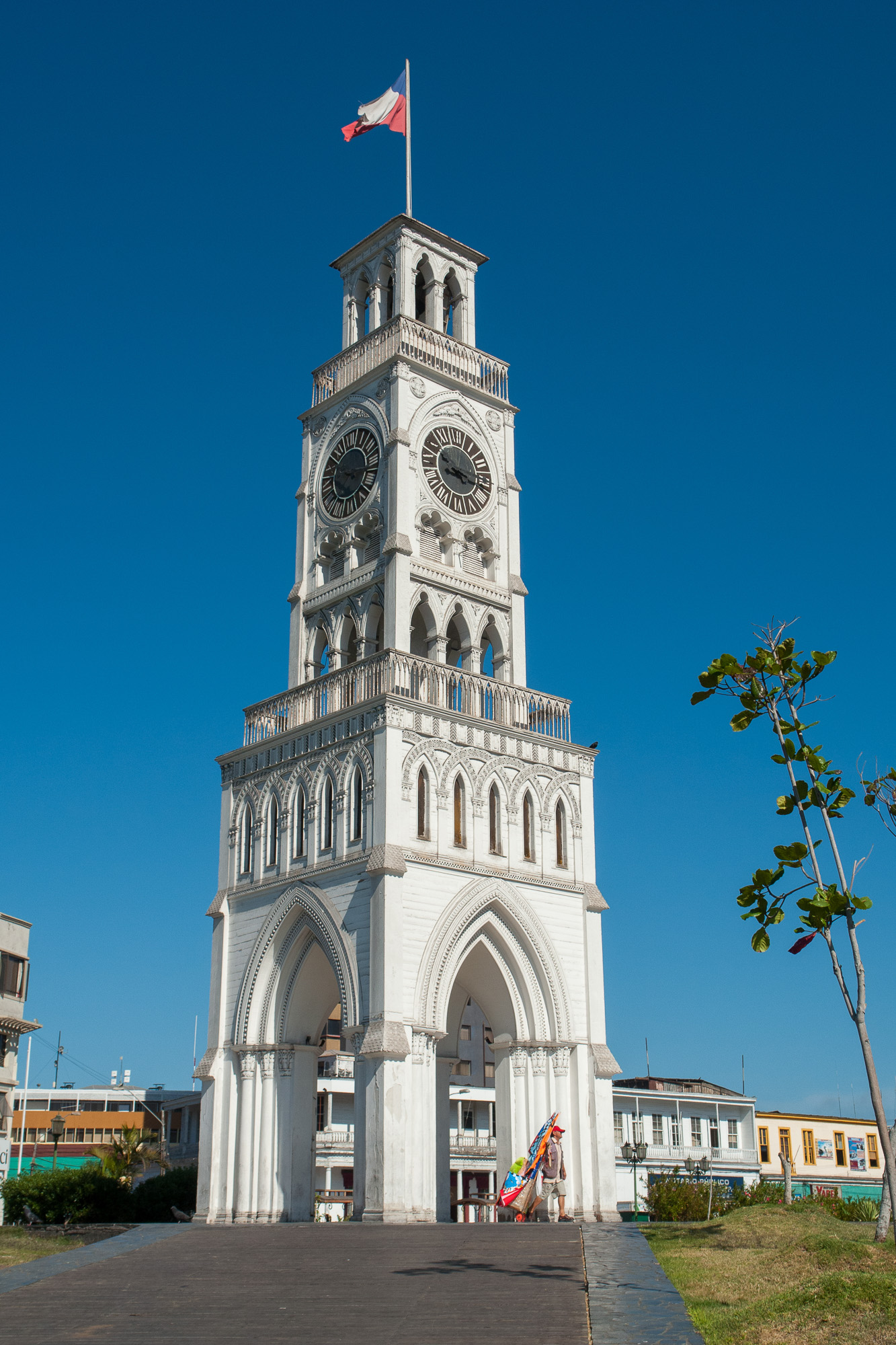
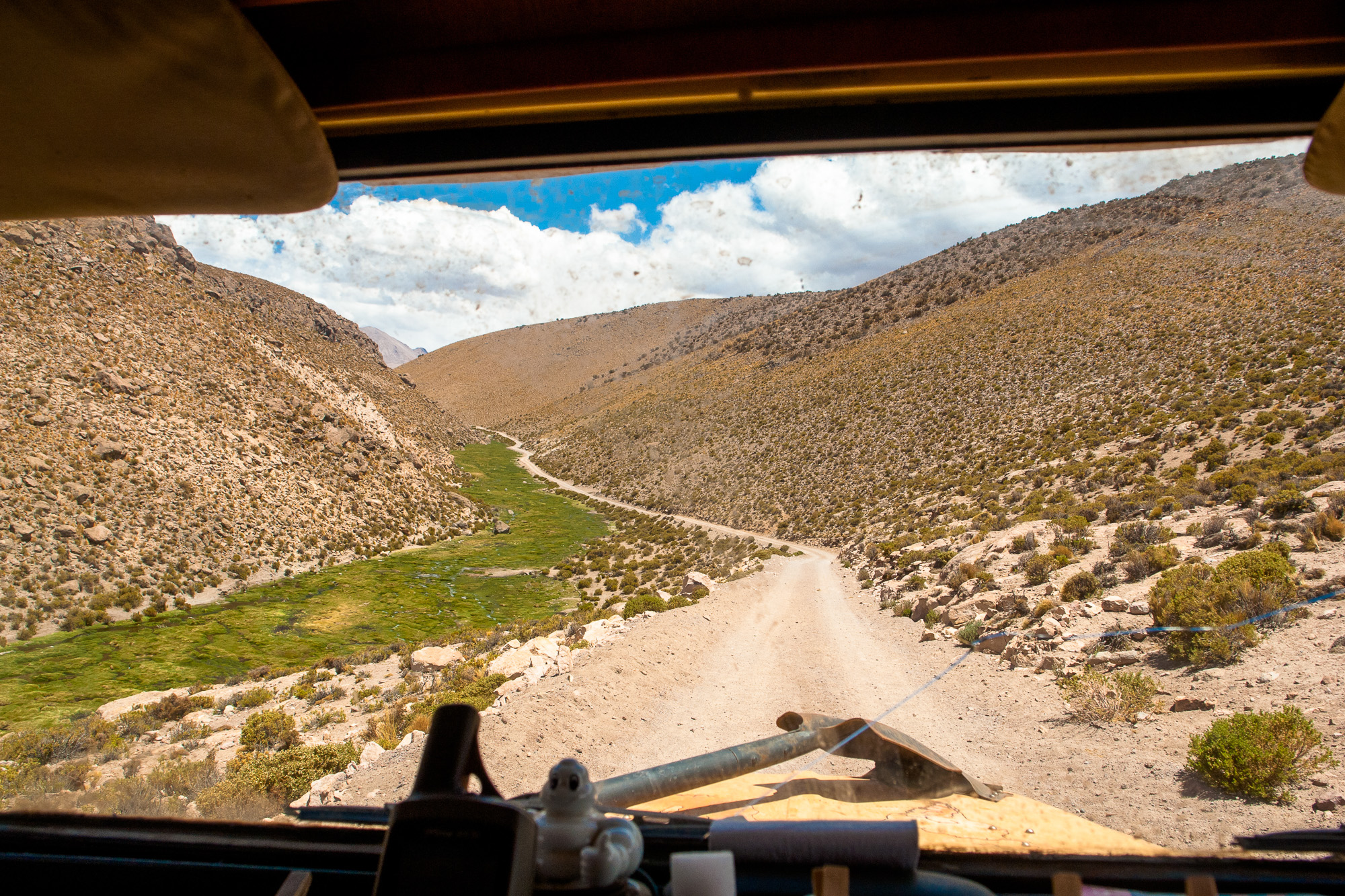
General Information
The calm of the desert may be misleading; at first sight, it feels as if nothing ever could have happened here. Yet, long before the Spanish colonized the continent, ethnic groups lived here, mainly along the coast. They left tangible remains of their lives through geoglyphs—figures created by removing stones or sand to make the contrast between the image and background visible. Early in the 19th century, the discovery of sodium nitrate changed the region forever. It was mined for the production of fertilizer and the manufacture of explosives. At its peak, the industry included 170 mines in operation, providing economic prosperity for 200,000 people. After the Germans invented synthetic fertilizer in the 1910s, the nitrate industry collapsed. Humberstone and the Santa Laura Factory, near Iquique, stand testimony to the heyday of nitrate mining and are UNESCO World Heritage Sites well worth a visit. The nitrate boom influenced the highlanders as well. They left the mountains to find economic prosperity in coastal towns, their homes turning into so-called ceremonial villages. Many kept their herds of llamas or alpacas, employing shepherds hired from Bolivia. Even today, former highlanders return for ceremonies and festivities, such as the Fiesta de las Flores, when they count and brand the newborns in the herd.
It is a good idea to read up on altitude sickness before you go. Due to the sudden increase of elevation from the coast to the high plains, slow acclimatization is well-nigh impossible. Some people have no problems, while others feel dizzy, get headaches, or, more seriously, altitude sickness. Make sure you know what the symptoms are (headache, vomiting, insomnia, and reduced performance and coordination), and if you have them, head down immediately to lower elevations. To minimize the chance of getting altitude sickness, drink lots of water and eat very little, preferably sticking to non-fatty foods. Refraining from drinking alcohol helps, too.
The Drive
In Iquique, stock up on water, fuel, and food, as you may have no other options until the end of day two in Pisagua. The 145-mile drive starts with a zigzag uphill on Ruta 16, which takes you to the ghost town of Humberstone and the Santa Laura Factory. From here, be sure to have sufficient fuel for the next 370 miles. Take a tip from us and fill up at one of the two fuel stations two miles south, and head north on Ruta 5, Chile’s section of the Pan-American Highway. Turn right onto Ruta 15; on your left, you will see the Gigante de Tarapacá, a 390-foot-long anthropomorphic geoglyph. Easy driving across asphalt takes you to the altiplano. Turn left onto A-487 and meander across a gravel road to Puchuldiza’s geothermal field at 13,800 feet. Pitch your vehicle or tent in the solitude of bare mountains, clear rivulets, and blue pools lined with sparkling white salt. Take a bath in the man-made pool and rise early because the steaming geysers are seen best around sunrise.
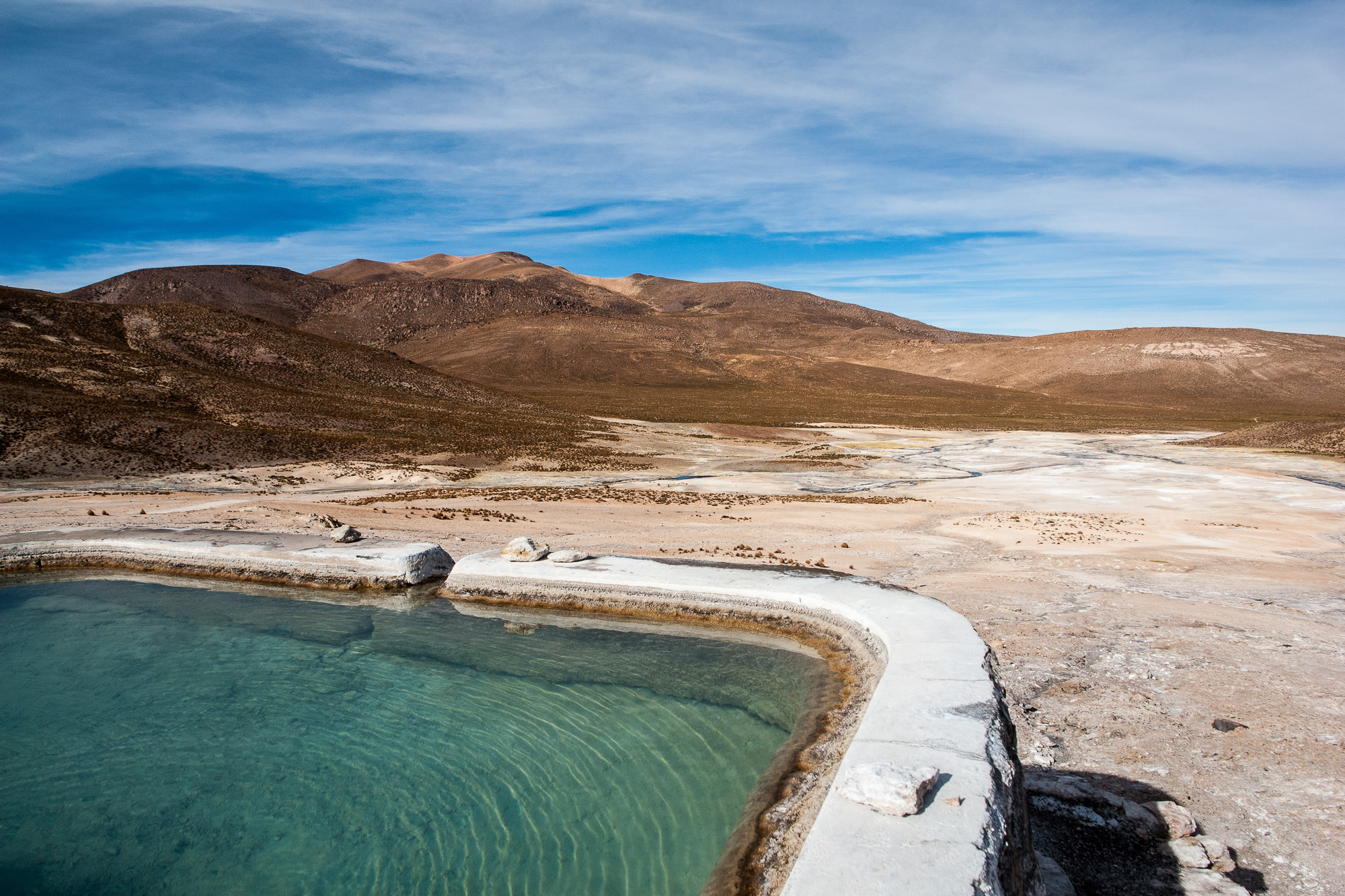
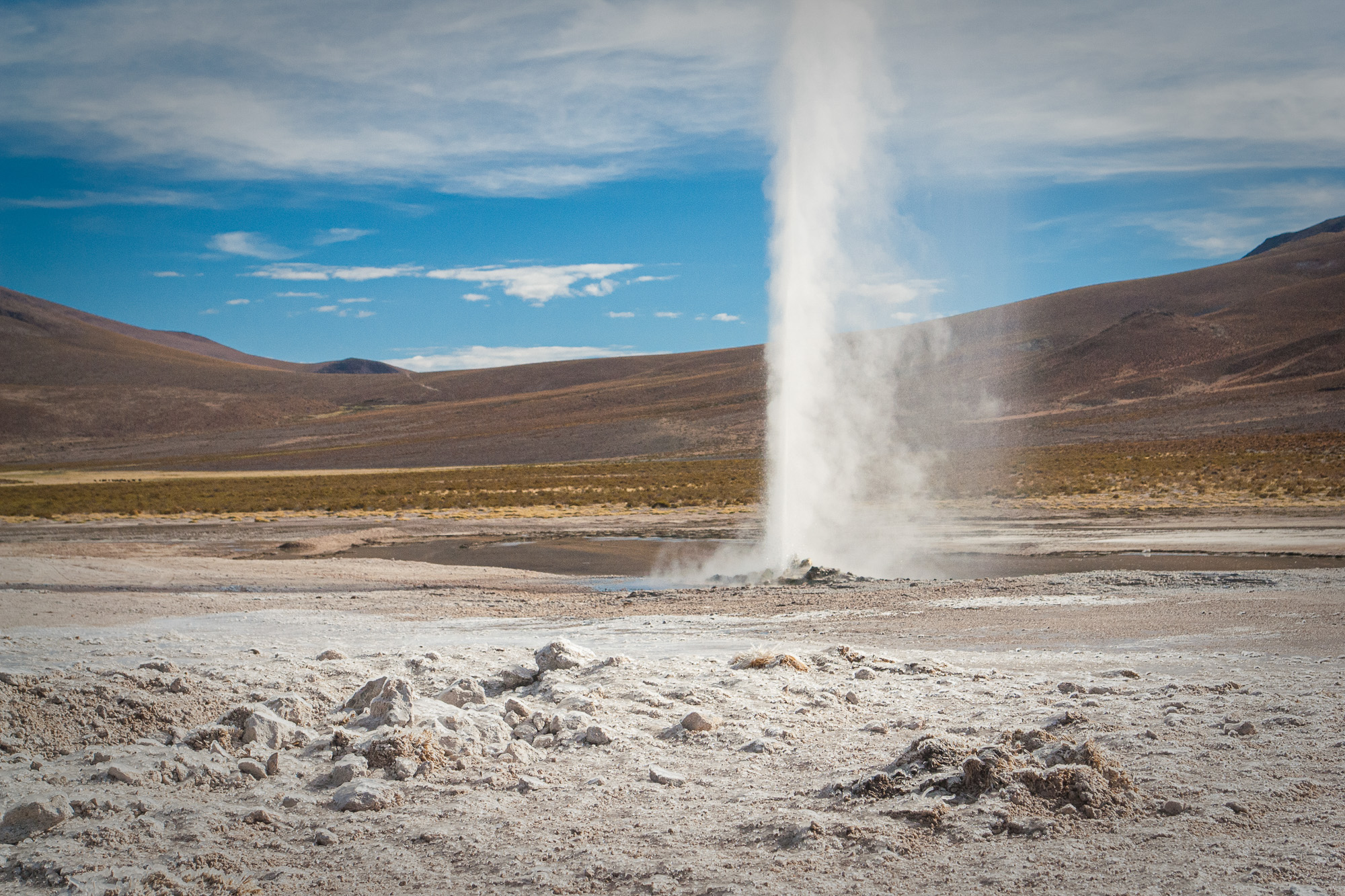
To start the 175-mile trip today, return the 15 miles to Ruta 15 and head north for 20 miles. In case you run short on fuel, drive on to the Bolivian border and ask if locals sell fuel, possibly from plastic canisters. Otherwise, turn west onto the A-385. Consider deflating the tires as you hit gravel for the 75-mile, gorgeous ride through Volcán Isluga National Park. You’ll move across the altiplano with mountain slopes dusted in a soft palette of ochre and orange tinges, with grazing alpacas and abandoned villages such as Isluga and its beautiful, white-plastered church. An optional slight detour will take you to Caraguano, two miles south of Enquelga. Spend the night there and enjoy a thermal bath or take a hike in the countryside.
The road continues to climb to 13,450 feet, with the Isluga Volcano off in the distance. The patches of moss on the rocks, lloreta compacta, were the area’s only source of fuel for centuries, but due to overharvesting, it is now a protected plant. After 29 miles, you reach a fork and turn left. At 15,255 feet, you cross the Portezuelo de Huinchuta Pass with a Pachamama shrine consisting of a pyramid of stones. Here, people offer drinks to Mother Earth for a safe journey.
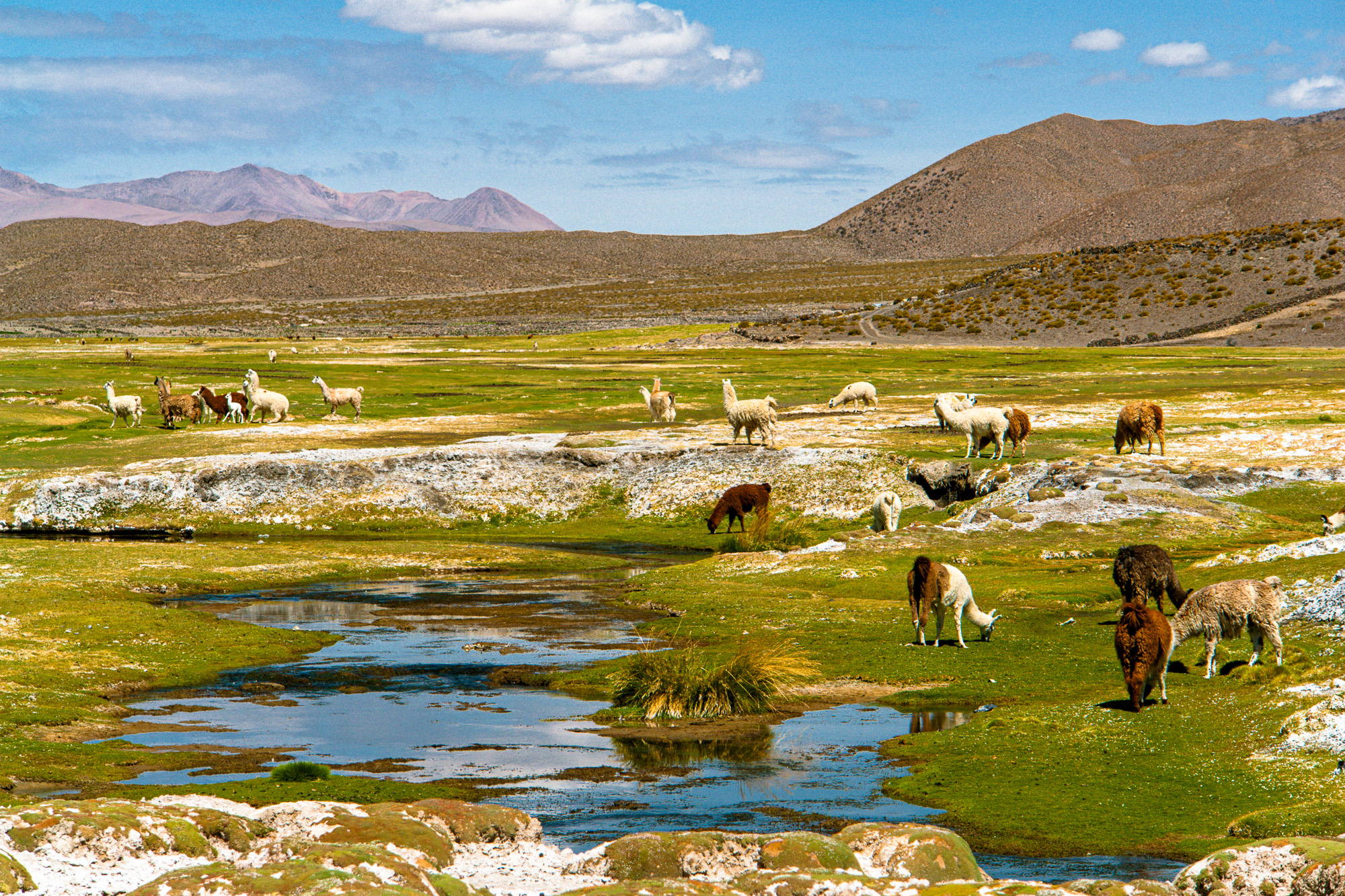
The road zigzags downhill through a barren landscape home to the candelabra tree. In the valley below lies Camiña amidst agricultural fields; the surplus of its harvest is sold in coastal cities. Smooth asphalt cuts downhill through the desert. Cross Ruta 5, after which the road plunges spectacularly down two dunes with the blue ocean in sight ahead of you. The port town of Pisagua fell into decay after the nitrate mining collapsed but has retained some of its charm, perhaps due to its seaside location and the remains of once-grand buildings. Check out the cemetery in the dunes, with a memorial next to the mass grave from the Pinochet era. You can free camp on the beach.
Return to Ruta 5, fill up at Pozo Almonte, and continue south to the Cerros Pintados. From a distance, you’ll spot the hills covered with some 400 geoglyphs, dating from 500-1400 CE. The “Painted Hills” have a visitor center and a dead-end trail with explanatory panels. Search for the details and unique images among the typical llamas and lizards, such as a huge arrow pointing down such as that you’d find at an airport, indicating a travelers’ meeting point. There are also one or two men on what seem to be skis but which are, in fact, boats made of inflated sea lion skins.
Take the paved A-75 back into gorgeous altiplano scenery. The region boasts salt plains and lakes, the famous Salar de Uyuni being right across the Bolivian border. You’ll spot herds of llamas and flocks of flamingos. At Salar de Huasco (12,465 feet), pick a spot to camp for the night, and go for a hike late in the day (or early morning) when the sun is less brutal and illuminates the landscape in soft hues. Bring out your chairs and a drink while you marvel as the daylight fades, the sky darkens, and stars pop up, one at a time. Wild camping doesn’t get much better than this.
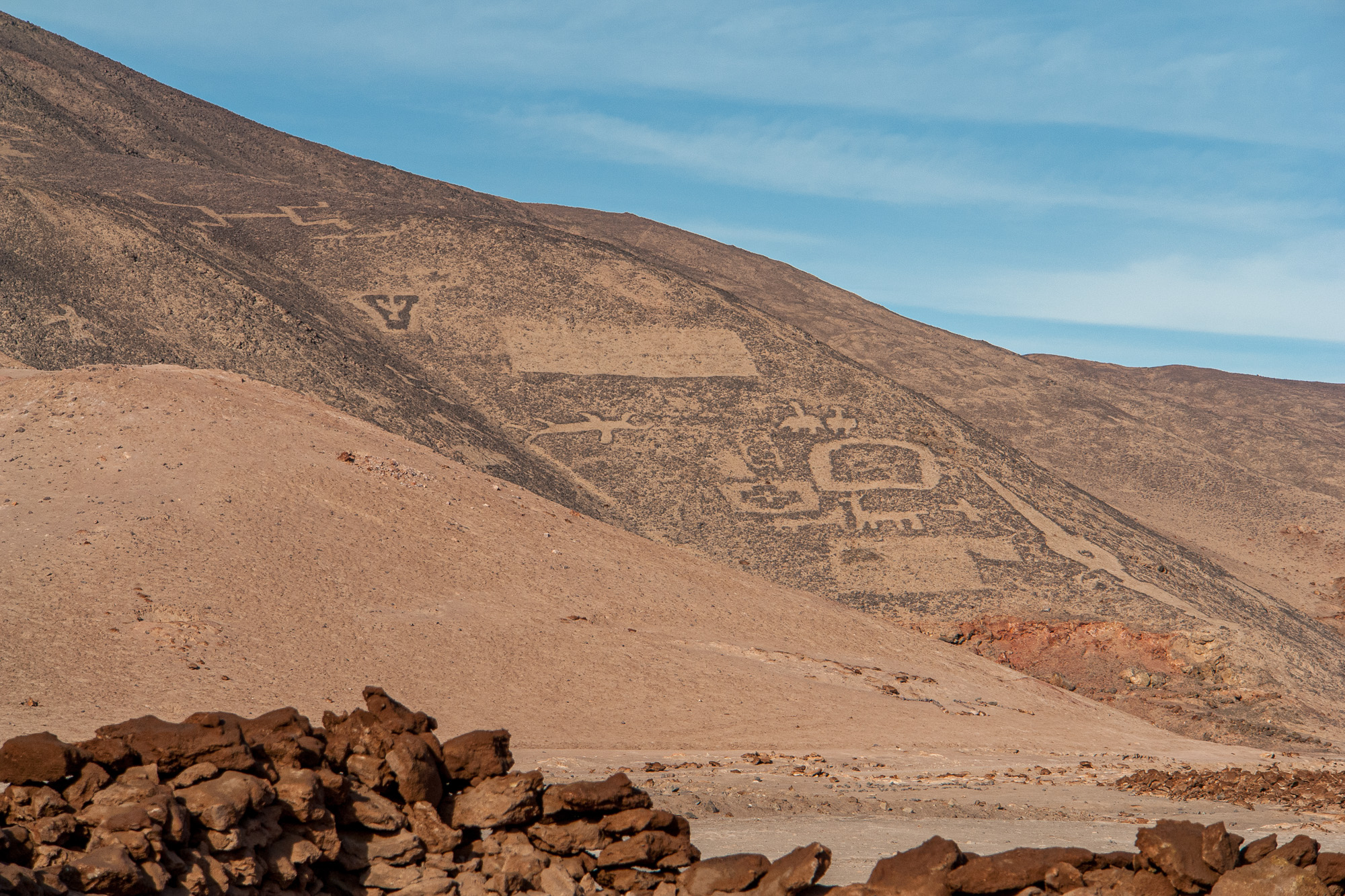
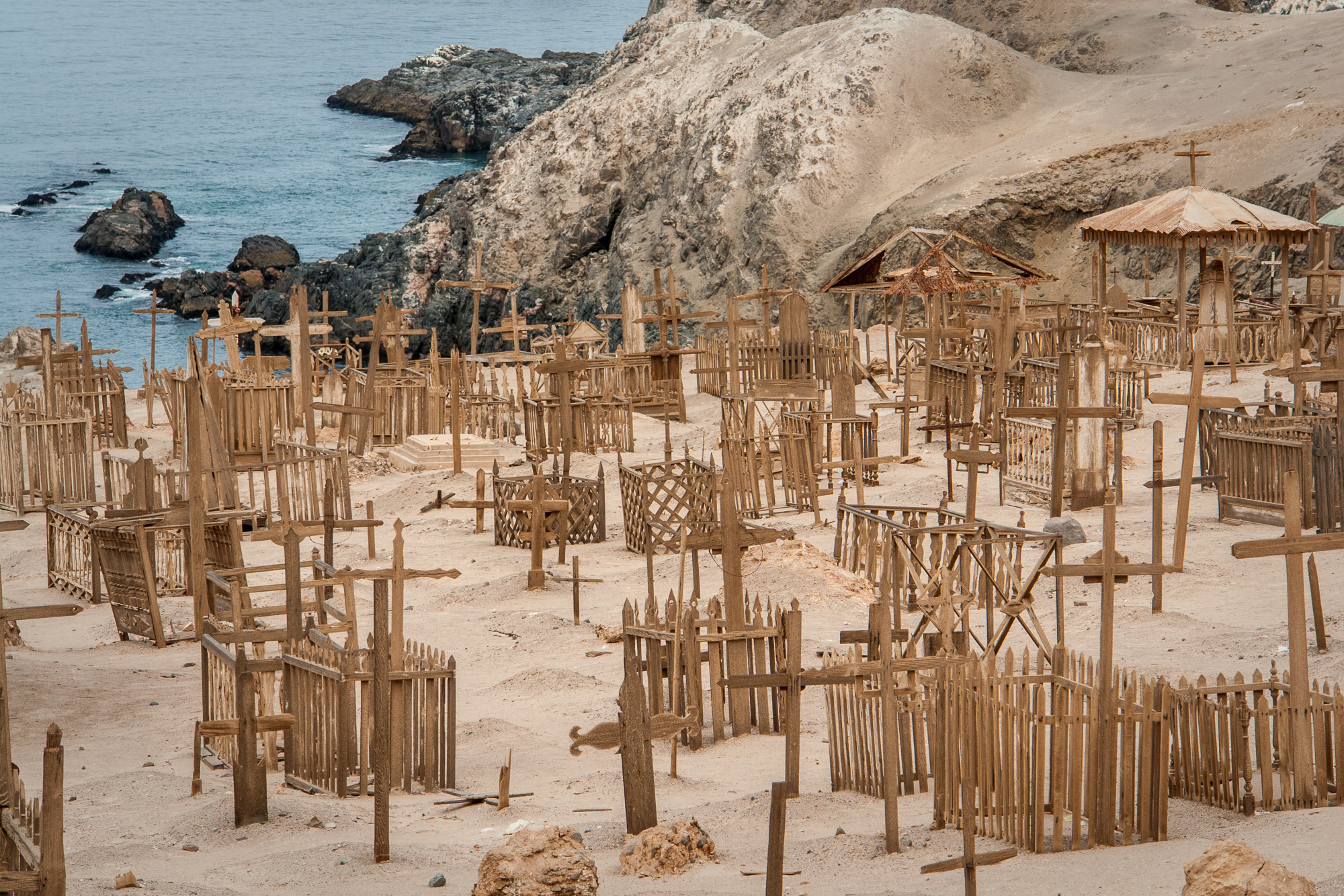
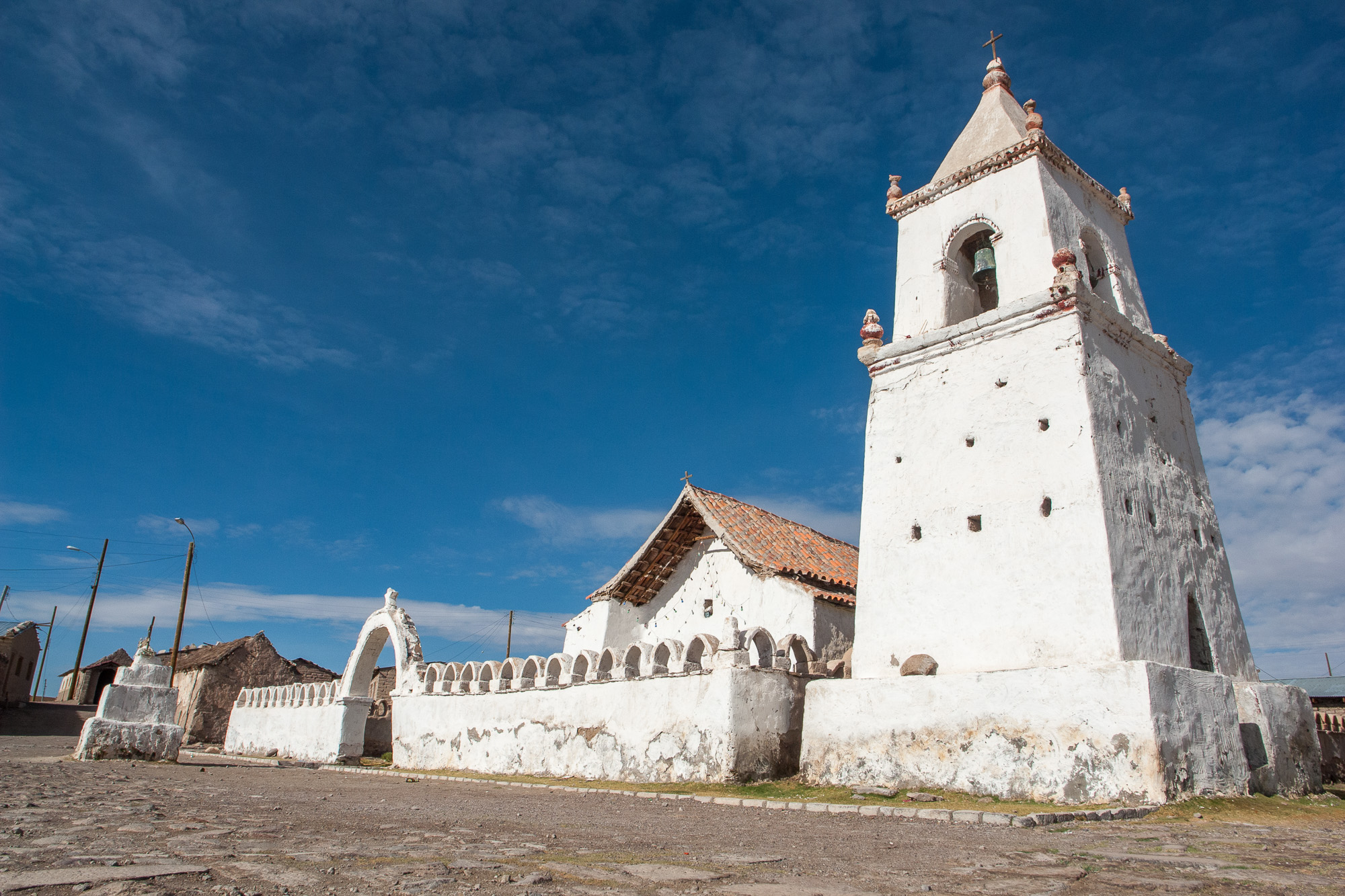

The return to Iquique is an easygoing 104 miles. Backtrack seven miles and turn right onto the A-651. Back on Ruta 5, you turn left at Humberstone to reach Iquique. Enjoy a paragliding flight or stroll downtown on the pedestrians-only streets. Check out the Museo Regional de Iquique to learn about the Chinchorro indigenous people and the nitrate industry, or the Museo Naval De Iquique, which showcases Chile’s naval history. For a good meal, head for the Restaurante Casino Español, with its unique old-world interior.
Atacama Desert: Access
When flying in, book a flight to Cavancha Airport, 25 miles south of Iquique, and rent a vehicle onsite.
If you’re overlanding, you’ll most likely arrive in Iquique via Ruta 5, the Pan-American Highway that cuts through the Atacama Desert.
Logistics
Total miles: 600
Suggested time: 4 days
Longest distance without fuel: 370 miles
Fuel Sources
Fuel sources are scarce. Apart from in Iquique, there are two fuel stations on Ruta 5 at Pozo Almonte (two miles south of Humberstone); both are open 24 hours.
Copec 20° 14′ 14.4” S, 69° 47′ 11.3″ W
Petrobras 20° 15′ 44.3″ S, 69° 47′ 08.4″ W
Difficulty (2.0 out of 5.0)
Part of the journey is on asphalt and part on gravel, and it is doable by 2WD. Only the section around Isluga may have some rocky, potholed areas requiring a high-clearance vehicle.
Atacama Desert: When To Go
The weather is pretty stable throughout the year, around 61-72°F, with very little rain, making this a year-round destination.
Permits and Fees
No permits are required. Entrance fees are needed for Humberstone (4,000 pesos), Thermos de Puchuldiza (around 3,000 pesos), and Cerros Pintados (4,000 pesos). Note that Cerros Pintados is closed on Mondays.
Suggested Campsites
Puchuldiza
Wild camp, 13.800 feet
19° 24′ 47.2″ S, 68° 57′ 36.3″ W
Pisagua
Wild camp, sea level
19° 35′ 23.6″ S, 70° 12′ 20.1″ W
Salar de Huasco
Wild camp, 12.465 feet
20° 16′ 32.8″ S, 68° 53′ 13.8″ W
Playa Lobito
Wild camp, nine miles south of Iquique at sea level; numerous camping spots along the coast moving south from Iquique
20° 24′ 10.3″ S, 70° 09′ 40.5″ W
Contacts
Recommended Hospitals in Chile internationalinsurance.com/hospitals/chile
Regional Hospital of Iquique, 24-hour ER hospitaliquique.cl, +56 57 240 5700
US Embassy in Chile cl.usembassy.gov
Registry of Museums of Chile (Humberstone) registromuseoschile.cl
Council of National Monuments of Chile (Pisagua) monumentos.gob.cl
Overland Routes, Atacama Desert: Resources
It is recommended that the traveler utilize redundant GPS devices (like a phone and a dedicated GPS), along with paper maps and a compass. This track, along with all other Overland Routes, can be downloaded on our website at overlandjournal.com/overland-routes/.
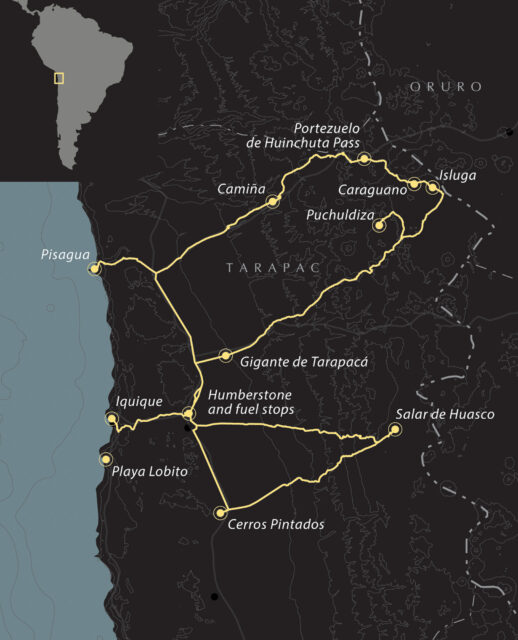
Overland Route descriptions are intended to be an overview of the trail rather than turn-by-turn instructions. We suggest you download an offline navigation app and our GPX track, as well as source detailed paper maps as an analog backup. As with any remote travel, circumstances can change dramatically. Drivers should check road conditions with local authorities before attempting the route and be ready to turn back should extreme conditions occur.
Editor’s Note: This article was originally published in Overland Journal’s Fall 2023 Issue.
Our No Compromise Clause: We do not accept advertorial content or allow advertising to influence our coverage, and our contributors are guaranteed editorial independence. Overland International may earn a small commission from affiliate links included in this article. We appreciate your support.
Read more: Ghost Towns of Chile by Karin-Marijke Vis


